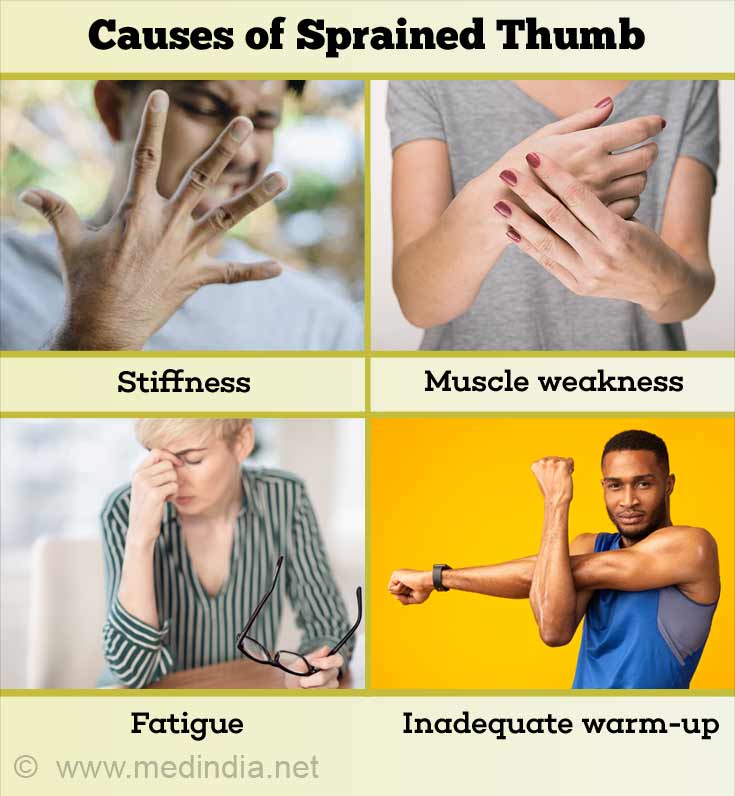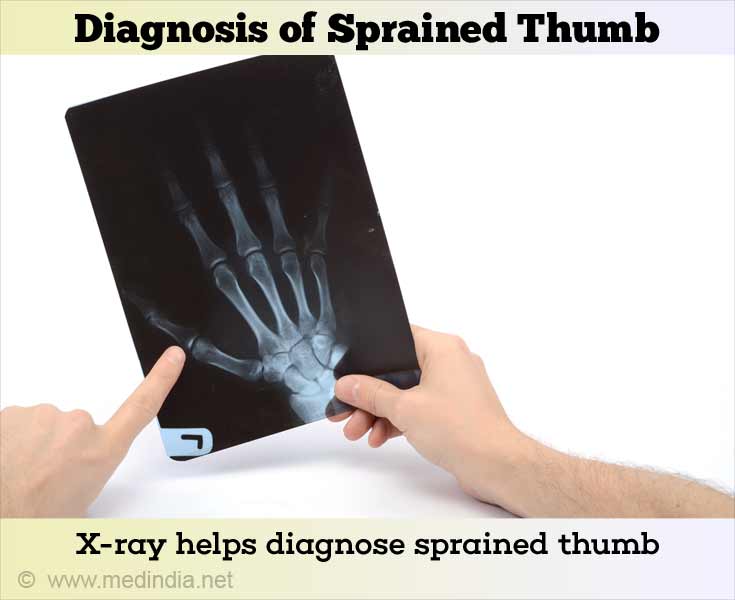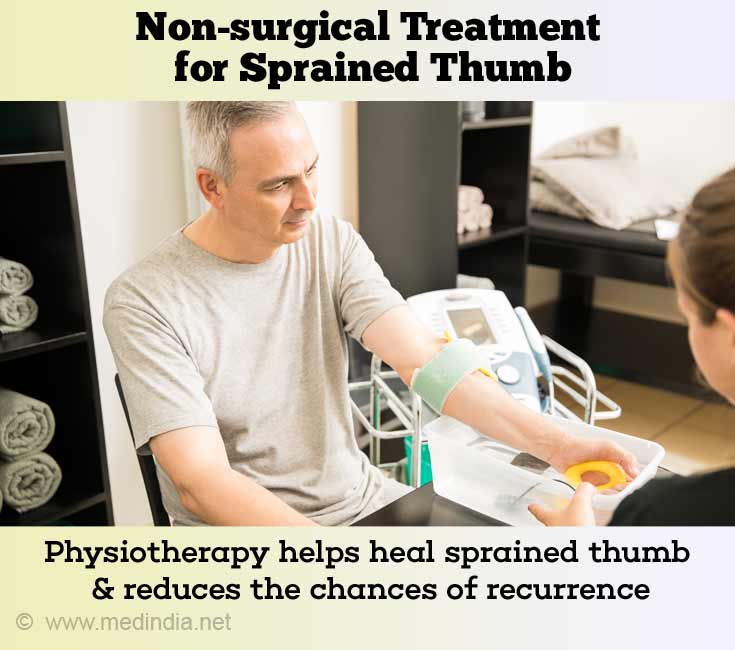- Thumb Sprains - (https://www.assh.org/handcare/hand-arm-injuries/thumb-sprains)
- Sprained Thumb - (https://www.rrmc.org/app/files/public/601/pdf-voc%20patient%20ed-Sprained_Thumb_VOC.pdf)
- About Sprained Thumb - (https://orthoinfo.aaos.org/en/diseases--conditions/sprained-thumb)
- Diagnosing Hand Sprains & Strains - (https://nyulangone.org/conditions/hand-sprains-strains/diagnosis)
- 5 Signs of a Thumb Sprain - (http://blog.handcare.org/blog/2018/01/17/5-signs-of-a-thumb-sprain/)
About
A thumb sprain is a soft tissue injury involving the connective tissues of the ligaments, cartilage and joint capsule of the thumb. It is a relatively common condition that can happen to anyone.(1✔ ✔Trusted Source
Thumb Sprains
Go to source)
A thumb injury, or a broken thumb, hinders activities that involve the hand such as pinching and grasping. A tear in the main ulnar collateral ligament, located at the base of the thumb, will weaken functions involving the thumb.
The thumb is made up of 2 small bones, the phalanges, which meet at the IP joint (interphalangeal joint). The phalanges meet the first metacarpal, which is the bone at the thumb side of the palm, at the MCP joint (metacarpophalangeal joint). Each of these two joints is wrapped by connective tissue which cushions the impact caused by the bones coming together during activities. If excessive stretching or compression forces are placed on these joints, the thumb is likely to get injured. This can cause tearing of the cartilage or the connective tissue surrounding the joints leading to a sprained thumb involving the IP or MCP joint.
Sprained Thumb - Causes
A sprained thumb is usually caused when you fall and exert your entire weight on an outstretched hand, injuring the ulnar collateral ligament of the thumb.
Although thumb sprains can occur to anyone, it is more likely to occur in those who indulge in sports such as basketball, netball or skiing. Here the sprain can occur either due to excessive backward bending of the thumb or excessive forward bending of the thumb or it can occur due to a sideways force. In those playing contact sports, thumb sprains can occur due to collision between players. In those playing martial arts, a thumb sprain can occur when the person tries to block a kick or deliver a punch.
When a skier falls on the slopes with hand strapped to a ski pole the thumb can get injured causing a sprain known as "skier's thumb."(2✔ ✔Trusted Source
Sprained Thumb
Go to source)
Occasionally, a sprained thumb can occur due to repetitive activities and overuse leading to stress in the thumb region.
A few causative factors include -
- Inadequate rehabilitation after a previous thumb sprain
- Avoiding the use of thumb braces or thumb taping during risky activities, after a previous thumb sprain
- Joint instability / Stiffness
- Muscle weakness
- Fatigue / decreased fitness
- Lack of co-ordination
- Inadequate warm-up
- Poor sporting techniques

Sprained Thumb - Symptoms
Symptoms of sprained thumb include -
- Pain
- Swelling
- Bruising
- Tenderness
- Discoloration (such as redness in the injured area)
- Tear in the ulnar collateral ligament
- Weakened ability to grasp things using the thumb and index finger
Symptoms tend to aggravate with activities that involve the injured hand. Many experience pain and stiffness in the sprained thumb after an activity followed by rest. Sometimes, the pain may spread to the wrists or hand. If a thumb dislocation occurs, it must be managed by a medical professional. A tear in the ulnar collateral ligament would require surgery.
If you develop thumb sprain make sure you seek medical attention as quickly as possible to avoid long–term complications.(3✔ ✔Trusted Source
About Sprained Thumb
Go to source, 4✔ ✔Trusted Source
5 Signs of a Thumb Sprain
Go to source)
Thumb sprain - Diagnosis
An examination by a physiotherapist is enough to diagnose thumb sprain.
The ulnar collateral ligament of the thumb is likely to be torn, either partially or completely. To help determine this, the physiotherapist or the doctor will rotate or move your thumb in different positions to determine the stability of your thumb joint.
Imaging tests such as X-ray, MRI, CT scan or ultrasound may also be ordered to confirm diagnosis, to determine the parts of the hand that are affected and to rule out other injuries, such as fractures. It is common to take an X- ray when a thumb sprain occurs.

A special type of test, called a stress x-ray, may be ordered to observe the joint as the doctor exerts pressure on to the injured ligament. If you experience pain during the test, as pressure is being applied, a local anesthetic may be administered. In some cases, the uninjured thumb may also be subjected to X-ray to compare it with the injured thumb.(5✔ ✔Trusted Source
Diagnosing Hand Sprains & Strains
Go to source)
Thumb sprain Treatment
Those who suffered a minor to moderate thumb sprain can return to normal activities in 2 – 6 weeks with proper treatment. Those with a more severe injury will need longer periods of rest and rehabilitation to return to normal activities.
Nonsurgical Treatment
Physiotherapy can speed up the process of healing a sprained thumb and reduce the chances of recurrence. Treatment may comprise:
- Thumb taping /thumb bracing
- Soft tissue massage
- Electrotherapy

- Joint mobilization
- Ice treatment/ heat treatment
- Exercises to speed up healing, improve flexibility and strength
- Helping the patient return to normal life
Thumb sprains can result in ligament tear. In case of a partial tear, the thumb joint will be immobilized using a cast, bandage or splint until the injury heals. Ice packs may be applied to the thumb twice a day to ease pain and swelling. After the first three weeks of wearing splint, it is removed to do thumb- strengthening exercises. You have to continue wearing splint at all other times until the injury is healed and the swelling and tenderness subsides.
Surgical Treatment
If the tear in the ulnar collateral ligament of the thumb is complete a surgery may have to be performed to reconnect the ligament to the bone, bring about healing and restore thumb function. Sometimes bone fragments come away with the ligament and this will have to be fixed with a pin or a screw. Once surgery is done, the hand will have to be kept immobilized in a cast or a splint for 6-8 weeks to bring about proper healing.
If a sprained thumb is not treated, it could result in long- term complications such as to chronic instability, weakness, or even arthritis. This will have to be rectified by restructuring the ligament using tissues from other parts of the body.
The following exercises are commonly advised to patients with thumb sprain. They must be done three times a day under the monitoring of a physiotherapist. Care must be taken to see that the symptoms do not worsen.
- Move your thumb to touch the tip of each finger, beginning with your index finger and ending with the little finger as shown in the figure. While doing, take care to see that the thumb stretches mildly or moderately and that there is no pain. Touch each finger 5-10 times.
- Move your thumb across your palm as far as possible without feeling pain. Repeat 10 times.







